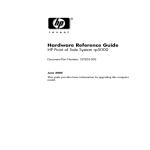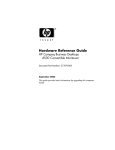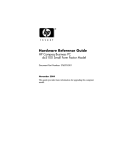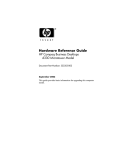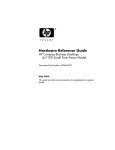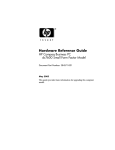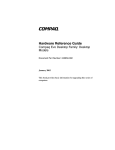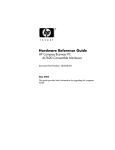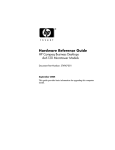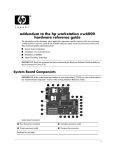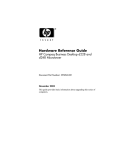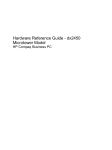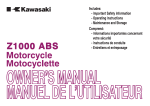Download HP Compaq dc5000S Hardware reference guide
Transcript
Hardware Reference Guide HP Compaq Business Desktop dc5000 Small Form Factor Model Document Part Number: 359513-001 January 2004 This guide provides basic information for upgrading this computer model. © Copyright 2004 Hewlett-Packard Development Company, L.P. The information contained herein is subject to change without notice. Microsoft, MS-DOS, Windows, and Windows NT are trademarks of Microsoft Corporation in the U.S. and other countries. Intel, Pentium, Intel Inside, and Celeron are trademarks of Intel Corporation in the U.S. and other countries. Adobe, Acrobat, and Acrobat Reader are trademarks or registered trademarks of Adobe Systems Incorporated. The only warranties for HP products and services are set forth in the express warranty statements accompanying such products and services. Nothing herein should be construed as constituting an additional warranty. HP shall not be liable for technical or editorial errors or omissions contained herein. This document contains proprietary information that is protected by copyright. No part of this document may be photocopied, reproduced, or translated to another language without the prior written consent of Hewlett-Packard Company. Å WARNING: Text set off in this manner indicates that failure to follow directions could result in bodily harm or loss of life. Ä CAUTION: Text set off in this manner indicates that failure to follow directions could result in damage to equipment or loss of information. Hardware Reference Guide HP Compaq Business Desktop dc5000 Small Form Factor Model First Edition January 2004 Document Part Number: 359513-001 Contents 1 Product Features Standard Configuration Features. . . . . . . . . . . . . . . . . . . . . . . . . . . . . . . . . . . . . . . . . . Front Panel Components . . . . . . . . . . . . . . . . . . . . . . . . . . . . . . . . . . . . . . . . . . . . . . . . Rear Panel Components . . . . . . . . . . . . . . . . . . . . . . . . . . . . . . . . . . . . . . . . . . . . . . . . Keyboard . . . . . . . . . . . . . . . . . . . . . . . . . . . . . . . . . . . . . . . . . . . . . . . . . . . . . . . . . . . . Windows Logo Key . . . . . . . . . . . . . . . . . . . . . . . . . . . . . . . . . . . . . . . . . . . . . . . . Special Mouse Functions. . . . . . . . . . . . . . . . . . . . . . . . . . . . . . . . . . . . . . . . . . . . . . . . Serial Number Location . . . . . . . . . . . . . . . . . . . . . . . . . . . . . . . . . . . . . . . . . . . . . . . . 1–1 1–2 1–3 1–4 1–5 1–6 1–6 2 Hardware Upgrades Serviceability Features . . . . . . . . . . . . . . . . . . . . . . . . . . . . . . . . . . . . . . . . . . . . . . . . . 2–1 Warnings and Cautions . . . . . . . . . . . . . . . . . . . . . . . . . . . . . . . . . . . . . . . . . . . . . . . . . 2–1 Using the Small Form Factor Computer in a Minitower Configuration . . . . . . . . . . . . 2–2 Removing the Computer Access Panel and Front Bezel. . . . . . . . . . . . . . . . . . . . . . . . 2–3 Installing Additional Memory . . . . . . . . . . . . . . . . . . . . . . . . . . . . . . . . . . . . . . . . . . . . 2–5 DIMMs . . . . . . . . . . . . . . . . . . . . . . . . . . . . . . . . . . . . . . . . . . . . . . . . . . . . . . . . . . 2–5 DDR-SDRAM DIMMs. . . . . . . . . . . . . . . . . . . . . . . . . . . . . . . . . . . . . . . . . . . . . . 2–5 DIMM Sockets . . . . . . . . . . . . . . . . . . . . . . . . . . . . . . . . . . . . . . . . . . . . . . . . . . . . 2–6 Installing an Expansion Card . . . . . . . . . . . . . . . . . . . . . . . . . . . . . . . . . . . . . . . . . . . 2–11 Installing Additional Drives . . . . . . . . . . . . . . . . . . . . . . . . . . . . . . . . . . . . . . . . . . . . 2–14 Locating Drive Positions . . . . . . . . . . . . . . . . . . . . . . . . . . . . . . . . . . . . . . . . . . . 2–15 Removing an Optical Drive or Diskette Drive . . . . . . . . . . . . . . . . . . . . . . . . . . . 2–16 Installing an Optional Optical Drive. . . . . . . . . . . . . . . . . . . . . . . . . . . . . . . . . . . 2–18 Upgrading the Hard Drive . . . . . . . . . . . . . . . . . . . . . . . . . . . . . . . . . . . . . . . . . . 2–21 Hardware Reference Guide www.hp.com iii Contents A Specifications B PATA Hard Drive Installation Guidelines Using the Cable-Select Feature with Parallel ATA (PATA) Devices. . . . . . . . . . . . . . B–1 Guidelines for Installing PATA Drives . . . . . . . . . . . . . . . . . . . . . . . . . . . . . . . . . B–1 C Battery Replacement D Security Lock Provisions Installing a Security Lock . . . . . . . . . . . . . . . . . . . . . . . . . . . . . . . . . . . . . . . . . . . . . . . D–1 E Port Security Bracket Installing the Port Security Bracket. . . . . . . . . . . . . . . . . . . . . . . . . . . . . . . . . . . . . . . . E–1 Removing the Port Security Bracket . . . . . . . . . . . . . . . . . . . . . . . . . . . . . . . . . . . . . . . E–6 F Electrostatic Discharge Preventing Electrostatic Damage . . . . . . . . . . . . . . . . . . . . . . . . . . . . . . . . . . . . . . . . . F–1 Grounding Methods. . . . . . . . . . . . . . . . . . . . . . . . . . . . . . . . . . . . . . . . . . . . . . . . . . . . F–1 G Routine Computer Care and Shipping Preparation Routine Computer Care. . . . . . . . . . . . . . . . . . . . . . . . . . . . . . . . . . . . . . . . . . . . . . . . . Optical Drive Precautions . . . . . . . . . . . . . . . . . . . . . . . . . . . . . . . . . . . . . . . . . . . . . . . Operation . . . . . . . . . . . . . . . . . . . . . . . . . . . . . . . . . . . . . . . . . . . . . . . . . . . . . . . . Cleaning . . . . . . . . . . . . . . . . . . . . . . . . . . . . . . . . . . . . . . . . . . . . . . . . . . . . . . . . . Safety . . . . . . . . . . . . . . . . . . . . . . . . . . . . . . . . . . . . . . . . . . . . . . . . . . . . . . . . . . . Shipping Preparation . . . . . . . . . . . . . . . . . . . . . . . . . . . . . . . . . . . . . . . . . . . . . . . . . . . G–1 G–2 G–2 G–2 G–2 G–3 Index iv www.hp.com Hardware Reference Guide 1 Product Features Standard Configuration Features The HP Compaq Small Form Factor features may vary depending on the model. For a complete listing of the hardware and software installed in the computer, run the Diagnostics for Windows utility. Instructions for using this utility are provided in the Troubleshooting Guide on the Documentation CD. use the computer in a minitower configuration, you must purchase ✎ Toa tower stand from HP (part number 316593-001).For more information, see the “Using the Small Form Factor Computer in a Minitower Configuration” section in this guide. Small Form Factor Configuration Hardware Reference Guide www.hp.com 1-1 Product Features Front Panel Components Drive configuration may vary by model. Front Panel Components 1 Diskette Drive Activity Light (optional) 7 USB (Universal Serial Bus) Ports 2 Diskette Drive (optional) 8 Hard Drive Activity Light 3 Diskette Eject Button (optional) 9 Power On Light 4 Optical Drive (CD-ROM, CD-R/RW, DVD-ROM, DVD +R/RW, or CD-RW/DVD Combo Drive) - Power Button 5 Microphone Connector q Optical Drive Activity Light 6 Headphone Jack w Optical Drive Eject Button 1-2 www.hp.com Hardware Reference Guide Product Features Rear Panel Components Rear Panel Components 1 Power Cord Connector 7 n RJ-45 Network Connector 2 Voltage Select Switch 8 l Parallel Connector PS/2 Mouse Connector 9 c Monitor Connector 3 b 4 a PS/2 Keyboard Connector - h Headphone/Line-Out Connector 5 o Universal Serial Bus (USB) q j Line-In Audio Connector 6 m w g Microphone Connector ✎ Serial Connector Arrangement and number of connectors may vary by model. When a PCI graphics card is installed, the connectors on the card and the system board may be used at the same time. Some settings may need to be changed in F10 setup to use both connectors. In F10 setup, go to Advanced > PCI VGA Configuration to change the settings. For more information about F10 setup, refer to the Computer Setup (F10) Utility Guide on the Documentation CD. Hardware Reference Guide www.hp.com 1-3 Product Features Keyboard Keyboard Components 1 Function Keys Perform special functions depending on the software application being used. 2 Editing Keys Includes the following: Insert, Home, Page Up, Delete, End, and Page Down. 3 Status Lights Indicate the status of the computer and keyboard settings (Num Lock, Caps Lock, and Scroll Lock). 4 Numeric Keys Work like a calculator keypad. 5 Arrow Keys Used to navigate through a document or Web site. These keys allow you to move left, right, up, and down, using the keyboard instead of the mouse. 6 Ctrl Key Used in combination with another key; its effect depends on the application software you are using. 7 Application Key* Used (like the right mouse button) to open pop-up menus in a Microsoft Office application. May perform other functions in other software applications. 1-4 www.hp.com Hardware Reference Guide Product Features Keyboard Components (Continued) 8 Windows Logo Key* Used to open the Start menu in Microsoft Windows. Used in combination with other keys to perform other functions. 9 Alt Key Used in combination with another key; its effect depends on the application software you are using. *Keys available in select geographic regions. Windows Logo Key Use the Windows Logo key in combination with other keys to perform certain functions available in the Windows operating system. Refer to the “Keyboard” section to identify the Windows Logo key. Windows Logo Key Functions Windows Logo Key Displays or hides the Start menu. Windows Logo Key + d Displays the Desktop. Windows Logo Key + m Minimizes all open applications. Shift + Windows Logo Key + m Undoes Minimize All. Windows Logo Key + e Launches My Computer. Windows Logo Key + f Launches Find Document. Windows Logo Key + Ctrl + f Launches Find Computer. Windows Logo Key + F1 Launches Windows Help. Windows Logo Key + l Locks the computer if you are connected to a network domain, or allows you to switch users if you are not connected to a network domain. Windows Logo Key + r Launches the Run dialog box. Windows Logo Key + u Launches the Utility Manager. Windows Logo Key + Tab Activates the next Taskbar button. Hardware Reference Guide www.hp.com 1-5 Product Features Special Mouse Functions Most software applications support the use of a mouse. The functions assigned to each mouse button depend on the software applications you are using. Serial Number Location Each computer has a unique serial number that is located on the top cover or the back panel of the computer. Keep this number available for use when contacting customer service for assistance. Serial Number Location 1-6 www.hp.com Hardware Reference Guide 2 Hardware Upgrades Serviceability Features This computer includes features that make it easy to upgrade and service. No tools are needed for most of the installation procedures described in this chapter. Warnings and Cautions Before performing upgrades be sure to carefully read all of the applicable instructions, cautions, and warnings in this guide. Å WARNING: To reduce the risk of personal injury from electrical shock and/or hot surfaces, be sure to disconnect the power cord from the wall outlet, and allow the internal system components to cool before touching. Å WARNING: To reduce the risk of electrical shock, fire, or damage to the equipment, do not plug telecommunications/telephone connectors into the network interface controller (NIC) receptacles. Ä CAUTION: Static electricity can damage the electronic components of the computer or optional equipment. Before beginning these procedures, ensure that you are discharged of static electricity by briefly touching a grounded metal object. Refer to Appendix F, “Electrostatic Discharge” in this guide for additional information on preventing electrostatic discharge. Ä CAUTION: Before removing the computer access panel ensure that the computer is turned off and that the power cord is disconnected from the electrical outlet. Hardware Reference Guide www.hp.com 2-1 Hardware Upgrades Using the Small Form Factor Computer in a Minitower Configuration The Small Form Factor computer can be used in either a minitower or desktop configuration. To use it in the minitower configuration, you must purchase a tower stand from HP (part number 316593-001). Ä CAUTION: If the computer is in the desktop configuration, ensure at least 4 inches (10.2 cm) of space on all sides of the computer remains clear and free of obstructions. To install the tower stand: 1. Align the hole at the base of the computer with the post and thumbscrew in the stand 12. 2. Tighten the screw to secure the computer to the stand 3. This adds stability and helps to ensure proper airflow to the internal components. 2-2 www.hp.com Hardware Reference Guide Hardware Upgrades Removing the Computer Access Panel and Front Bezel To remove the computer access panel: 1. Turn off the computer properly through the operating system, then turn off any external devices. 2. Disconnect the power cord from the power outlet and the computer, and disconnect any external devices. Ä CAUTION: Before removing the computer access panel, ensure that the computer is turned off and that the power cord is disconnected from the electrical outlet. 3. On the top of the computer, locate the cover latch. Pull up and hold the latch 1 to release the computer access panel. 4. Slide the computer access panel back 2 about 0.5 inch (1.25 cm), then lift the access panel up and off the chassis. Removing the Computer Access Panel Hardware Reference Guide www.hp.com 2-3 Hardware Upgrades 5. To remove the front bezel, gently pull up all three tabs 1 on the top of the bezel, then pull the bezel 2 away from the chassis. Removing the Front Bezel To reassemble the computer, reverse the above procedure. Press down while replacing the access panel. Refer to the label on the inside of the access panel for more information. the front bezel, insert the two bezel bottom tabs, then ✎ Torotatere-install the front bezel forward to snap the three tabs on the top of the bezel in place. 2-4 www.hp.com Hardware Reference Guide Hardware Upgrades Installing Additional Memory The computer comes with double data rate synchronous dynamic random access memory (DDR-SDRAM) dual inline memory modules (DIMMs). DIMMs The memory sockets on the system board can be populated with up to four industry-standard DIMMs. These memory sockets are populated with at least one preinstalled DIMM. To achieve the maximum memory support, you can populate the system board with up to 4GB of memory configured in a high-performing dual channel mode. DDR-SDRAM DIMMs For proper system operation, if the computer supports DDR-SDRAM DIMMs, the DIMMs must be: ■ industry-standard 184-pin ■ unbuffered PC2100 266 MHz-, PC2700 333 MHz-, or PC3200 400 MHz-compliant ■ 2.5 volt DDR-SDRAM DIMMs. The DDR-SDRAM DIMMs must also: ■ support CAS latency 2 or 2.5 (CL = 2 or CL = 2.5) ■ contain the mandatory JEDEC SPD information In addition, the computer supports: Hardware Reference Guide ■ 128Mbit, 256Mbit, and 512Mbit non-ECC memory technologies ■ single-sided and double-sided DIMMS ■ DIMMs constructed with x8 and x16 DDR devices; DIMMs constructed with x4 SDRAM are not supported www.hp.com 2-5 Hardware Upgrades The following processor bus frequencies are required for the system to run at the supported memory frequencies. Memory Frequency Required Processor Bus Frequency 266 MHz 400 MHz, 533 MHz, or 800 MHz 333 MHz 533 MHz or 800 MHz 400 MHz 800 MHz If a memory frequency is paired with an unsupported processor bus frequency, the system will run at the highest supported memory speed. For example, if a 333 MHz DIMM is paired with a 400 MHz processor bus, the system will run at 266 MHz, the highest supported memory speed. ✎ The system will not start if you install unsupported DIMMs. DIMM Sockets The system will automatically operate in single channel mode or a higher-performing dual channel mode, depending on how the DIMMs are installed. 2-6 ■ In single channel mode, the maximum operational speed is determined by the slowest DIMM in the system. For example, if the system is populated with a DIMM that is 266 MHz and a second DIMM that is 333 MHz, the system will run at the slower of the two speeds. ■ In dual channel mode, all DIMMs must be identically matched. DIMMs in the XMM1 and XMM3 black sockets must be identical; DIMMs in the XMM2 and XMM4 blue sockets must also be identical. Therefore, if you have one preinstalled DIMM in socket XMM1 and are adding a second DIMM, it is recommended that you install an identical DIMM into the XMM3 socket. If you are populating all four DIMM sockets, use identical DIMMs in each socket. Otherwise, the system will not operate in dual channel mode. www.hp.com Hardware Reference Guide Hardware Upgrades There are four DIMM sockets on the system board, with two sockets per channel. The sockets are labeled XMM1, XMM2, XMM3, and XMM4. Sockets XMM1 and XMM2 operate in memory channel A. Sockets XMM3 and XMM4 operate in memory channel B. DIMM Socket Locations Item Hardware Reference Guide Description Socket Color 1 DIMM socket XMM4, Channel B Blue 2 DIMM socket XMM3, Channel B Black 3 DIMM socket XMM2, Channel A Blue 4 DIMM socket XMM1, Channel A Black www.hp.com 2-7 Hardware Upgrades Installing DDR-SDRAM DIMMs Ä CAUTION: The memory module sockets have gold metal contacts. When upgrading the memory, it is important to use memory modules with gold metal contacts to prevent corrosion and/or oxidation resulting from having incompatible metals in contact with each other. Ä CAUTION: Static electricity can damage the electronic components of the computer or optional cards. Before beginning these procedures, ensure that you are discharged of static electricity by briefly touching a grounded metal object. Refer to Appendix F, “Electrostatic Discharge” for more information. Ä CAUTION: When handling a memory module, be careful not to touch any of the contacts. Doing so may damage the module. 1. Turn off the computer properly through the operating system, then turn off any external devices. 2. Disconnect the power cord from the power outlet and disconnect any external devices. 3. Remove the computer access panel and front bezel. Ä 2-8 CAUTION: Check the position of all cables and wires before raising or lowering the Easy Access drive bay to prevent damage. www.hp.com Hardware Reference Guide Hardware Upgrades 4. Rotate the Easy Access drive bay to an upright position. Rotating the Easy Access Drive Bay 5. Locate the memory module sockets. Å Hardware Reference Guide WARNING: To reduce risk of personal injury from hot surfaces, allow the internal system components to cool before touching. www.hp.com 2-9 Hardware Upgrades 6. Open both latches of the memory module socket 1, then insert the memory module into the socket 2. Installing a DIMM module can be installed in only one way. Match the notch ✎ Aonmemory the module with the tab on the memory socket. you have one preinstalled DIMM in socket XMM1 and are adding a ✎ Ifsecond DIMM, it is recommended that you install an identical DIMM into the XMM3 socket. Otherwise, the computer will not operate in dual channel mode. 7. Push the module down into the socket, ensuring that the module is fully inserted and properly seated. Make sure the latches are in the closed position 3. 2-10 www.hp.com Hardware Reference Guide Hardware Upgrades 8. Repeat steps 7 and 8 for any additional modules that you want to install. 9. Return the Easy Access drive bay to the down position. Be sure not to pinch the cables in the chassis when lowering the Easy Access drive bay. 10. Replace the front bezel and computer access panel. The computer automatically recognizes the additional memory the next time you power on the computer. Installing an Expansion Card The computer has three PCI expansion slots. Each slot can accommodate an expansion card up to 6.875 inches (17.46 cm) in length. To install an expansion card: 1. Turn off the computer properly through the operating system, then turn off any external devices. 2. Disconnect the power cord from the power outlet and disconnect any external devices. 3. Remove the computer access panel. 4. Identify the slot into which you want to insert the expansion card. Hardware Reference Guide www.hp.com 2-11 Hardware Upgrades 5. Release the slot cover retention latch 1 that secures the slot covers by pulling the latch up. 6. Remove the slot cover by sliding the slot cover up and pulling it toward the inside of the chassis 2. Removing the Expansion Slot Cover 2-12 www.hp.com Hardware Reference Guide Hardware Upgrades 7. Install the expansion card by carefully placing the expansion card under the slot cover retention latch 1, then firmly pushing the expansion card into the connector 2. Ensure that the expansion card is firmly and properly seated in the expansion card slot. sure not to scrape other components in the chassis when installing ✎ Be an expansion card. Installing an Expansion Card 8. Push the expansion slot latch down 3 to secure the expansion card in place. 9. If you are not replacing the old expansion card with a new expansion card, install an expansion slot cover to close the open slot. Insert the metal slot cover in the open slot, then push the expansion slot latch down to secure the slot cover in place. Ä Hardware Reference Guide CAUTION: After removing an expansion card, you must replace it with a new card or cover the open slot (for example, with a metal slot cover) for proper cooling of internal components during operation.) www.hp.com 2-13 Hardware Upgrades Installing Additional Drives The computer has two external drive bays. When installing additional drives, follow these guidelines: ■ For optimal performance, connect hard drives to the primary controller. Connect expansion devices, such as optical, IDE tape, and diskette drives, to the secondary controller using an 80-conductor IDE cable. ■ Install guide screws to ensure the drive will line up correctly in the drive cage and lock in place. HP has provided extra guide screws (four 6-32 standard screws and four M3 metric screws), installed in the front of the chassis, behind the bezel. The hard drive uses 6-32 standard screws. All other drives use M3 metric screws. The HP-supplied metric screws are black and the HP-supplied standard screws are silver. Ä■ CAUTION: To prevent loss of work and damage to the computer or drive: 2-14 If you are inserting or removing a hard drive, shut down the operating system properly, then turn off the computer. Do not remove a hard drive while the computer is on or in standby mode. ■ Before handling a drive, ensure that you are discharged of static electricity. While handling a drive, avoid touching the connector. For more information about preventing electrostatic damage, see Appendix F, “Electrostatic Discharge.” ■ ■ ■ Handle a drive carefully; do not drop it. ■ If a drive must be mailed, place the drive in a bubble-pack mailer or other suitable protective packaging and label the package “Fragile: Handle With Care.” Do not use excessive force when inserting a drive. Avoid exposing a hard drive to liquids, temperature extremes, or products that have magnetic fields such as monitors or speakers. www.hp.com Hardware Reference Guide Hardware Upgrades Locating Drive Positions Desktop Drive Positions 1 3.5-inch drive bay (optional 1.44-MB diskette drive shown)* 2 5.25-inch drive bay for optional drives 3 3.5-inch, internal, standard hard drive bay *If the computer has a 1.44-MB diskette drive installed, it will be configured with a diskette drive bezel as shown in the illustration. If the computer contains an empty 3.5-inch drive bay, then a bezel blank will be installed on the computer instead. If you do not have a drive in this slot, you may choose to install a 3.5-inch device (such as a diskette drive, hard drive, or Zip drive) later on. However, to install a 3.5-inch device other than a diskette drive or hard drive, you must order the 3.5-inch device bezel (PN 316008-001). To verify the type, size, and capacity of the storage devices installed in the computer, run Computer Setup. Refer to the Computer Setup (F10) Utility Guide for more information. Hardware Reference Guide www.hp.com 2-15 Hardware Upgrades Removing an Optical Drive or Diskette Drive Ä CAUTION: All removable media should be taken out of the drives before removing the drive from the computer. optical drive is a CD-ROM, CD-RW, DVD +R/RW or DVD-ROM ✎ An drive. 1. Turn off the computer properly through the operating system, then turn off any external devices. 2. Disconnect the power cord from the power outlet and disconnect any external devices. 3. Remove the computer access panel and front bezel. 4. Raise the Easy Access drive bay to the upright position. 5. Disconnect the audio, signal, and drive power cables. The other end of the audio cable should remain connected to the audio connector on the system board. 6. Return the Easy Access drive bay to the down position. 2-16 www.hp.com Hardware Reference Guide Hardware Upgrades 7. Push the drive release latch 1 toward the rear of the chassis and hold. 8. Slide the drive 2 toward the front of the drive cage, then lift the drive out of the computer. Removing the Optical Drive or Diskette Drive To replace the drive, reverse the removal procedures. replacing the drive, transfer the four screws from the old drive ✎ When to the new one. The screws take the place of drive rails. Hardware Reference Guide www.hp.com 2-17 Hardware Upgrades Installing an Optional Optical Drive To install an optional optical drive: 1. Remove the optical drive if present. 2. Install two guide screws in the lower holes on each side of the drive. Ä CAUTION: Use only 3/16-inch or 5-mm long screws as guide screws. Longer screws can damage the internal components of the drive. replacing the drive, transfer the four screws from the old drive ✎ When to the new one. The screws take the place of drive rails. Installing Guide Screws in the Optical Drive 2-18 www.hp.com Hardware Reference Guide Hardware Upgrades 3. Position the guide screws on the drive into the J-slots in the drive bay 1. Then, slide the drive toward the rear of the computer 2. Installing the Optical Drive drive release latch automatically locks in place when installing a ✎ The drive. Hardware Reference Guide www.hp.com 2-19 Hardware Upgrades 4. Raise the Easy Access drive bay to the upright position and connect the flat ribbon cable and audio cable to the system board. Connecting the Power Cable, Flat Ribbon Cable and Audio Cable 5. Connect the power cable, flat ribbon cable, and audio cable to the rear of the optical drive. 6. Return the Easy Access drive bay to the down position. Be sure not to pinch the cables in the chassis when lowering the Easy Access drive bay. 7. Replace the front bezel and computer access panel. The system automatically recognizes the drive and reconfigures the computer. Ä 2-20 CAUTION: When servicing the computer, ensure that cables are placed in their proper locations during the reassembly process. Improper cable placement can damage the computer. www.hp.com Hardware Reference Guide Hardware Upgrades Upgrading the Hard Drive Removing and Replacing the Hard Drive parallel advanced technology attachment (PATA) hard drives ✎ Only can be installed on this computer. Make sure to back up the data on the old hard drive before removing it so that you can install the data onto the new hard drive. The preinstalled 3.5-inch hard drive is located on the right side of the computer. To remove and replace the hard drive: 1. Turn off the computer properly through the operating system, then turn off any external devices. 2. Disconnect the power cord from the power outlet and disconnect any external devices. 3. Remove the computer access panel and front bezel. 4. Raise the Easy Access drive bay to the upright position. 5. Disconnect the power cable and data cable from the back of the drive. Hardware Reference Guide www.hp.com 2-21 Hardware Upgrades 6. Press and hold the drive release latch 1. 7. Slide the drive to the right of the bay 2, then pull the drive from the bay 3. Removing the Hard Drive 8. To install a hard drive, reverse the above procedure. 2-22 www.hp.com Hardware Reference Guide Hardware Upgrades 9. Connect the power cable 1 and data cable 2 to the hard drive. Connecting the Data Cable and Power Cable Hardware Reference Guide www.hp.com 2-23 Hardware Upgrades 10. Connect the opposite end of the data cable to the appropriate system board connector 1. Hard Drive Connector Locations replacing the hard drive, transfer the four screws from the old ✎ When drive to the new one. The screws take the place of drive rails. You will need a Torx T-15 screwdriver to remove and re-install the guide screws. you have installed a PATA hard drive that is not automatically ✎ Ifrecognized by the computer, see Appendix B, “PATA Hard Drive Installation Guidelines.” replaced the primary hard drive, insert the Restore Plus! CD ✎ toIf you restore the operating system, software drivers, and any software applications that were preinstalled on the computer. Follow the instructions in the guide included with the Restore Plus! CD. When the restore process has completed, reinstall any personal files that you backed up before replacing the hard drive. 2-24 www.hp.com Hardware Reference Guide Hardware Upgrades Installing a Drive into the 3.5-inch Drive Bay Depending on the computer configuration, the 3.5-inch drive bay on the left side of the computer may be configured with a diskette drive or it may be an empty drive bay. The type of bezel covering the drive bay will vary depending on the original computer configuration. If the computer was not configured with the optional diskette drive, you can install a 3.5-inch device, such as a diskette drive or hard drive, into the drive bay at any time. type of bezel you need will depend on the type of device you plan ✎ The to install. If you are installing a diskette drive, you must install a diskette drive bezel (PN 316002-001). If you are installing a hard drive, you must install a bezel blank (PN 316006-001). If you are installing a 3.5-inch device other than a diskette drive or hard drive, you must install the 3.5-inch device bezel (PN 316008-001). Contact an authorized HP reseller or service provider to order the appropriate bezel when reconfiguring the computer. a secondary PATA hard drive, you must use a dual-headed ✎ Tocableinstall (part number 108950-051). Hardware Reference Guide www.hp.com 2-25 Hardware Upgrades Guide Screw Locations guide screws on a 3.5-inch diskette drive 1 are placed closer ✎ The together than on the hard drive 2. To install a drive into the bay: 1. Turn off the computer properly through the operating system, then turn off any external devices. 2. Disconnect the power cord from the power outlet and disconnect any external devices. 3. Remove the computer access panel and front bezel. 2-26 www.hp.com Hardware Reference Guide Hardware Upgrades 4. Remove the diskette drive bezel by pushing the tab inward 1 and pulling the diskette drive bezel 2 away from the front bezel. ✎ The type of bezel will vary depending on the computer configuration. Removing the Diskette Drive Bezel Hardware Reference Guide www.hp.com 2-27 Hardware Upgrades 5. Insert the rear screws of the hard drive 1 into the rear J-slots. Slide the drive 2 toward the back of the drive cage until the front screws are aligned with the front J-slots. Then lower the front of the drive. Continue to slide the drive all the way back until it locks into place. a diskette drive, the guide screws (front and rear) will line ✎ Ifupreplacing on the J-slots. Insert the guide screws into the J-slots, then slide the drive toward the back of the drive cage until it locks into place. Installing a Hard Drive into the 3.5-inch Drive Bay (connectors may vary) 2-28 www.hp.com Hardware Reference Guide Hardware Upgrades 6. Replace with the appropriate bezel by pushing the bezel into place. type of bezel you need will depend on the type of device you are ✎ The installing. If you are installing a diskette drive, you must install a diskette drive bezel (PN 316002-001). If you are installing a hard drive, you must install a bezel blank (PN 316006-001) as shown in the illustration below. If you are installing a 3.5-inch device other than a diskette drive or hard drive, you must install the 3.5-inch device bezel (PN 316008-001). Contact an authorized HP reseller or service provider to order the appropriate bezel when reconfiguring the computer. 7. Connect the power and data cables. 8. Replace the front bezel and computer access panel. you have installed a PATA hard drive that is not automatically ✎ Ifrecognized by the computer, see Appendix B, “PATA Hard Drive Installation Guidelines.” Hardware Reference Guide www.hp.com 2-29 Hardware Upgrades 2-30 www.hp.com Hardware Reference Guide A Specifications the computer is in the desktop configuration, ensure at least 4 ✎ Ifinches (10.2 cm) of space on all sides remains clear and free of obstructions. HP Compaq dc5000 Small Form Factor Desktop Dimensions Height 3.95 inches 10.3 cm Width 13.3 inches 33.78 cm Depth (depth will increase if the computer is equipped with a port security bracket) 15.1 inches 38.35 cm 21 lb 9.53 kg Operating 50° to 95° F 10° to 35° C Nonoperating -22° to 140° F -30° to 60° C Operating 10–90% 10–90% Nonoperating (38.7° C max wet bulb) 5–95% 5–95% Operating 10,000 ft 3048 m Nonoperating 30,000 ft 9144 m Approximate Weight Temperature Range Relative Humidity (noncondensing) Maximum Altitude (unpressurized) ✎ Operating temperature is derated 1.0° C per 300 m (1000 ft) to 3000 m (10,000 ft) above sea level, no direct sustained sunlight. Maximum rate of change is 10° C/Hr. The upper limit may be limited by the type and number of options installed. Hardware Reference Guide www.hp.com A-1 Specifications HP Compaq dc5000 Small Form Factor Power Supply ✎ Operating Voltage Range 90–132 VAC 180–264 VAC Rated Voltage Range 100–127 VAC 200–240 VAC Rated Line Frequency 50–60 Hz 50–60 Hz This system utilizes a passive power factor corrected power supply when used in the 230V mode. This allows the system to pass the CE mark requirements for use in the countries of the European Union. Power Output 185 W 185 W Rated Input Current (maximum) 5 A @ 100 VAC 2.5 A @ 200 VAC Maximum 971 BTU/hr 245 kg-cal/hr Typical (idle) 256 BTU/hr 65 kg-cal/hr Heat Dissipation A-2 www.hp.com Hardware Reference Guide B PATA Hard Drive Installation Guidelines Using the Cable-Select Feature with Parallel ATA (PATA) Devices Optional drives are available from HP in kits that include a special drive cable. The configuration of the drive employs a cable-select feature that identifies the drive as device 0 (primary drive) or device 1 (secondary drive). Device 1 is the drive connected to the cable’s middle connector. Device 0 is the drive connected to the cable’s end connector (applies only to 80-conductor ATA cables). See “Guidelines for Installing PATA Drives” in this appendix for an example of an PATA cable. HP hard drives ship with jumpers preset to cable-select mode; therefore, no jumper setting changes on the existing or optional drives are required. If you purchase a third-party hard drive, refer to the documentation included with the kit to ensure proper installation and configuration of cables. a second device on the primary controller, you must use ✎ Ifaninstalling 80-conductor PATA cable for optimal performance. This cable is standard on select models. Guidelines for Installing PATA Drives When installing additional drives, follow these guidelines: Hardware Reference Guide ■ If using multiple devices, HP recommends that the devices be split between the primary and secondary channels for optimum performance. Use an additional cable to connect the additional device to the system board. ■ 80-conductor PATA cable: www.hp.com B–1 PATA Hard Drive Installation Guidelines ❏ 18 inches maximum total length, 80-conductor cable with maximum spacing of 6 inches between Device 0 and Device 1. 80-Conductor PATA Cable 1 Device 0 (primary drive) connector 2 Device 1 (secondary drive) connector 3 System board connector ■ For optimal performance, connect hard drives to the primary controller. Connect expansion devices, such as ATA optical drives and tape drives, to the secondary controller. ■ Install either a third-height or a half-height drive into a half-height bay. ■ Install guide screws to ensure that the drive lines up correctly in the drive cage. Hard drives use 6-32 standard guide screws. Four extra guide screws are installed on the hard drive bracket under the access panel. HP-supplied standard screws are silver. ■ If only one device is connected to a cable, that device must be attached to the end (Device 0) connector. you have only one device, make sure to connect it to the Device 0 ✎ Ifconnector. If you connect it to the Device 1 connector, the system will not recognize the device and you may receive a “no fixed disk found” error message. B–2 www.hp.com Hardware Reference Guide C Battery Replacement The battery that comes with the computer provides power to the real-time clock. When replacing the battery, use a battery equivalent to the battery originally installed in the computer. The computer comes with a 3-volt lithium coin cell battery. lifetime of the lithium battery can be extended by plugging the ✎ The computer into a live AC wall socket. The lithium battery is only used when the computer is NOT connected to AC power. Å WARNING: The computer contains an internal lithium manganese dioxide battery. There is a risk of fire and burns if the battery is not handled properly. To reduce the risk of personal injury: ■ ■ ■ Do not attempt to recharge the battery. ■ Replace the battery only with the HP spare designated for this product. Do not expose to temperatures higher than 60° C (140º F). Do not disassemble, crush, puncture, short external contacts, or dispose of in fire or water. Ä CAUTION: Before replacing the battery, it is important to back up the computer CMOS settings. When the battery is removed or replaced, the CMOS settings will be cleared. Refer to the Troubleshooting Guide on the Documentation CD for information on backing up the CMOS settings. N Batteries, battery packs, and accumulators should not be disposed of together with the general household waste. In order to forward them to recycling or proper disposal, please use the public collection system or return them to HP, their authorized partners, or their agents. Hardware Reference Guide www.hp.com C-1 Battery Replacement Ä CAUTION: Static electricity can damage the electronic components of the computer or optional equipment. Before beginning these procedures, ensure that you are discharged of static electricity by briefly touching a grounded metal object. 1. Turn off the computer properly through the operating system, then turn off any external devices. Disconnect the power cord from the power outlet and disconnect any external devices. Then remove the computer access panel. be necessary to remove an expansion card to gain access to ✎ Itthemay battery. 2. Locate the battery and battery holder on the system board. 3. Depending on the type of battery holder on the system board, complete the following instructions to replace the battery. Type 1 a. Lift the battery out of its holder. Removing a Coin Cell Battery (Type 1) C-2 www.hp.com Hardware Reference Guide Battery Replacement b. Slide the replacement battery into position, positive side up. The battery holder automatically secures the battery in the proper position. Type 2 a. To release the battery from its holder, squeeze the metal clamp that extends above one edge of the battery. b. When the battery pops up, lift it out. Removing a Coin Cell Battery (Type 2) Hardware Reference Guide www.hp.com C-3 Battery Replacement c. To insert the new battery, slide one edge of the replacement battery under the holder’s lip with the positive side up. Push the other edge down until the clamp snaps over the other edge of the battery. Replacing a Coin Cell Battery (Type 2) the battery has been replaced, use the following steps to ✎ After complete this procedure. 4. Replace the computer access panel. 5. Plug in the computer and turn on power to the computer. 6. Reset the date and time, your passwords, and any special system setups, using Computer Setup. Refer to the Computer Setup (F10) Utility Guide. C-4 www.hp.com Hardware Reference Guide D Security Lock Provisions Installing a Security Lock The security locks displayed below and on the following page can be used to secure the computer. present, insert the cable lock in the location shown below. The ✎ Ifcable lock can also be inserted in the secondary hole highlighted below. I Installing a Cable Lock Hardware Reference Guide www.hp.com D-1 Security Lock Provisions Installing a Padlock D-2 www.hp.com Hardware Reference Guide E Port Security Bracket Installing the Port Security Bracket 1. Insert the tabs on the bottom half of the port security bracket into the slots on the back of the chassis 1 and rotate the bracket toward the chassis 2. Hardware Reference Guide www.hp.com E-1 Port Security Bracket 2. Connect the cables to the computer. E-2 www.hp.com Hardware Reference Guide Port Security Bracket 3. On the top of the computer, locate the cover latch. Pull up and hold the latch 1 to release the computer access panel. 4. Slide the computer access panel back 2 about 0.5 inch (1.25 cm), then lift the access panel up and off the chassis. Hardware Reference Guide www.hp.com E-3 Port Security Bracket 5. Position the top of the port security bracket over the cables 1 and rotate the bracket into place 2. E-4 www.hp.com Hardware Reference Guide Port Security Bracket 6. Replace the computer access panel. Hardware Reference Guide www.hp.com E-5 Port Security Bracket Removing the Port Security Bracket 1. On the top of the computer, locate the cover latch. Pull up and hold the latch 1 to release the computer access panel. 2. Slide the computer access panel back 2 about 0.5 inch (1.25 cm), then lift the access panel up and off the chassis. E-6 www.hp.com Hardware Reference Guide Port Security Bracket 3. Rotate the top of the bracket away from the chassis. Hardware Reference Guide www.hp.com E-7 Port Security Bracket 4. Disconnect the cables from the computer. E-8 www.hp.com Hardware Reference Guide Port Security Bracket 5. Push on the tabs to release the bottom of the bracket from the chassis 1. Rotate the bracket away from the chassis 2. Hardware Reference Guide www.hp.com E-9 Port Security Bracket E-10 www.hp.com Hardware Reference Guide F Electrostatic Discharge A discharge of static electricity from a finger or other conductor may damage system boards or other static-sensitive devices. This type of damage may reduce the life expectancy of the device. Preventing Electrostatic Damage To prevent electrostatic damage, observe the following precautions: ■ Avoid hand contact by transporting and storing products in static-safe containers. ■ Keep electrostatic-sensitive parts in their containers until they arrive at static-free workstations. ■ Place parts on a grounded surface before removing them from their containers. ■ Avoid touching pins, leads, or circuitry. ■ Always be properly grounded when touching a static-sensitive component or assembly. Grounding Methods There are several methods for grounding. Use one or more of the following methods when handling or installing electrostatic-sensitive parts: ■ Hardware Reference Guide Use a wrist strap connected by a ground cord to a grounded workstation or computer chassis. Wrist straps are flexible straps with a minimum of 1 megohm +/- 10 percent resistance in the ground cords. To provide proper ground, wear the strap snug against the skin. www.hp.com F-1 Electrostatic Discharge ■ Use heelstraps, toestraps, or bootstraps at standing workstations. Wear the straps on both feet when standing on conductive floors or dissipating floor mats. ■ Use conductive field service tools. ■ Use a portable field service kit with a folding static-dissipating work mat. If you do not have any of the suggested equipment for proper grounding, contact an HP authorized dealer, reseller, or service provider. more information on static electricity, contact an HP authorized ✎ For dealer, reseller, or service provider. F-2 www.hp.com Hardware Reference Guide G Routine Computer Care and Shipping Preparation Routine Computer Care Follow these suggestions to take care of the computer and monitor: Hardware Reference Guide ■ Operate the computer on a sturdy, level surface. Leave a 3-inch (7.6-cm) clearance at the back of the system unit and above the monitor to permit the required airflow. ■ Never operate the computer with the cover or side panel removed. ■ Never restrict the airflow into the computer by blocking the front vents or air intake. Do not place the keyboard, with the keyboard feet down, directly against the front of the desktop unit as this also restricts airflow. ■ Keep the computer away from excessive moisture, direct sunlight, and extremes of heat and cold. For information about the recommended temperature and humidity ranges for the computer, refer to Appendix A, “Specifications” in this guide. ■ Keep liquids away from the computer and keyboard. ■ Never cover the ventilation slots on the monitor with any type of material. ■ Turn off the computer before you do either of the following: ❏ Wipe the exterior of the computer with a soft, damp cloth as needed. Using cleaning products may discolor or damage the finish. ❏ Occasionally clean the air vents on the front and back of the computer. Lint and other foreign matter can block the vents and limit the airflow. www.hp.com G-1 Routine Computer Care and Shipping Preparation Optical Drive Precautions Be sure to observe the following guidelines while operating or cleaning the optical drive. Operation ■ Do not move the drive during operation. This may cause it to malfunction during reading. ■ Avoid exposing the drive to sudden changes in temperature, as condensation may form inside the unit. If the temperature suddenly changes while the drive is on, wait at least one hour before you turn off the power. If you operate the unit immediately, it may malfunction while reading. ■ Avoid placing the drive in a location that is subject to high humidity, extreme temperatures, mechanical vibration, or direct sunlight. ■ Clean the panel and controls with a soft, dry cloth or a soft cloth lightly moistened with a mild detergent solution. Never spray cleaning fluids directly on the unit. ■ Avoid using any type of solvent, such as alcohol or benzene, which may damage the finish. Cleaning Safety If any object or liquid falls into the drive, immediately unplug the computer and have it checked by an authorized HP service provider. G-2 www.hp.com Hardware Reference Guide Routine Computer Care and Shipping Preparation Shipping Preparation Follow these suggestions when preparing to ship the computer: 1. Back up the hard drive files on PD discs, tape cartridges, CDs, or diskettes. Be sure that the backup media is not exposed to electrical or magnetic impulses while stored or in transit. hard drive locks automatically when the system power is ✎ The turned off. 2. Remove and store any program diskettes from the diskette drives. 3. Insert a blank diskette into the diskette drive to protect the drive while in transit. Do not use a diskette on which you have stored or plan to store data. 4. Turn off the computer and external devices. 5. Disconnect the power cord from the electrical outlet, then from the computer. 6. Disconnect the system components and external devices from their power sources, then from the computer. that all boards are seated properly and secured in the board ✎ Ensure slots before shipping the computer. 7. Pack the system components and external devices in their original packing boxes or similar packaging with sufficient packing material to protect them. environmental nonoperating ranges, see Appendix A, ✎ For “Specifications” in this guide. Hardware Reference Guide www.hp.com G-3 Routine Computer Care and Shipping Preparation G-4 www.hp.com Hardware Reference Guide Index 3.5-inch drive bay 2–25 A access panel, removing 2–3 application key 1–4 arrow keys 1–4 audio connector 1–3 B battery coin cell (type 1) C–2 coin cell (type 2) C–3 battery replacement C–1 bezel 2–27 bezel blank, removing 2–27 C cable optical drive 2–20 cable lock, installation D–1 coin cell battery type 1 C–2 type 2 C–3 components front panel 1–2 keyboard 1–4 rear panel 1–3 computer care,guidelines G–1 CTRL key 1–4 D DDR-SDRAM 2–5 DIMMs 2–5 Hardware Reference Guide installation 2–8 diskette drive activity light 1–2 eject button 1–2 removing 2–16 drive installation, guidelines 2–14 drive positions 2–15 E editing keys 1–4 eject button, optical drive 1–2 electrostatic discharge 2–1, F–1 expansion card cage, removing 2–14 expansion card, installing 2–11, 2–13 expansion slot cover, removing 2–12 F front bezel, removing 2–4 front panel components 1–2 function keys 1–4 G guidelines battery replacement C–1 computer care G–1 drive installation 2–14 optical drive G–2 shipping preparation G–3 H hard drive 3.5-inch 2–25 activity light 1–2 www.hp.com Index-1 Index guide screws 2–26 installing PATA 2–28, B–1 PATA cable B–1 removing 2–22 restoring 2–24 upgrading 2–21 headphone jack 1–2 headphone line-out connector 1–3 I installation guidelines 2–14 installing 3.5-inch hard drive 2–25 cable lock D–1 coin cell battery (type 1) C–3 coin cell battery (type 2) C–4 expansion card 2–11, 2–13 hard drive 2–28 memory 2–5 optical drive 2–18 padlock D–2 port security bracket E–1 K keyboard components 1–4 port 1–3 L lock D–1, D–2 M memory dual channel mode 2–6 identifying 2–10 installing 2–5 locating sockets 2–6 specifications 2–5 microphone connector 1–2, 1–3 monitor connector 1–3 mouse Index-2 connector 1–3 special functions 1–6 N numeric keys 1–4 O optical drive activity light 1–2 ATA B–2 connecting cables 2–20 eject button 1–2 guidelines G–2 installing 2–18 precautions G–2 removing 2–16 P padlock, installation D–2 parallel connector 1–3 PCI card See expansion card port security bracket installing E–1 removing E–6 power button 1–2 cord connector 1–3 light 1–2 R rear panel components 1–3 removing bezel blank 2–27 coin cell battery (type 1) C–2 coin cell battery (type 2) C–3 computer access panel 2–3 diskette drive 2–16 expansion card cage 2–14 expansion slot cover 2–12 front bezel 2–4 www.hp.com Hardware Reference Guide Index hard drive 2–22 optical drive 2–16 port security bracket E–6 RJ-45 connector 1–3 routine care G–1 S security lock provisions D–1 serial connector 1–3 Hardware Reference Guide serial number location 1–6 shipping preparation, guidelines G–3 status lights 1–4 U USB 1–2, 1–3 W Windows Logo key 1–5 www.hp.com Index-3





































































